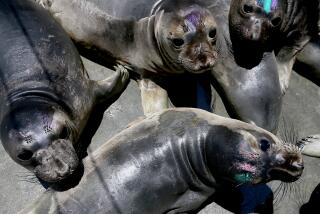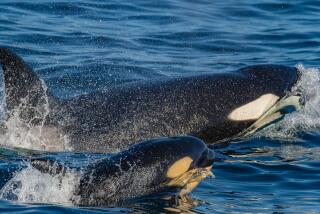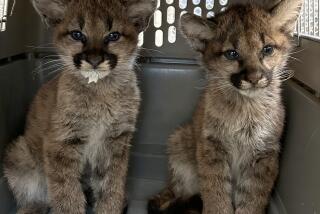Hurricane Irma pounded the Florida Keys, but now they’re back — some say better than ever
Andi Kimbrel is passionate about sea lions. Good thing, because Hurricane Irma forced her to live with them for five months.
When the storm, one of the most destructive hurricanes in history, took aim at the Florida Keys in September, Kimbrel was working as a mammal trainer at Theater of the Sea in the island village of Islamorada. Word came to evacuate, but no one wanted to leave behind the small theme park’s eight sea lions.
They were loaded into a converted semi-truck and hauled north. Kimbrel rode in the trailer, baby- or, rather, sea lion-sitting.
The end of the line was near Sarasota, Fla., where the sea lion colony holed up at a watery, temporary home. Kimbrel and two other trainers holed up too, staying with their raucous charges until the severely damaged theme-park tanks could be repaired.
Kimbrel and Wilbur the sea lion were the last to leave more than five months later.
She didn’t mind spending time with them. “It’s like they’re my kids,” she said. “Things had changed here, but we were happy to come home.”
More than six months after Irma roared through the Keys, many things have changed. Once-bountiful mangrove forests have been depleted, piles of ripped up concrete litter some areas and housing is at a premium.
Up and running
But many other things in the Keys are the same and in many cases even better, I found during a recent trip.
Visitors no longer have to worry about finding a place to stay: 84% of the region’s hotel rooms are back online. Most of those that were damaged have been refurbished or are new.
For the most part, tourist businesses are up and running and can brag about improvements.
For instance, Theater of the Sea, one of the oldest marine mammal facilities in the world, has changed dramatically. There are new landscaping, tanks and repaired buildings.
But the family-owned park still offers visitors the thing it has excelled in since its opening in 1946: a chance to learn about dolphins, sea lions and other marine animals and birds.
Kids can watch big boys Wilbur and Tucker and sweet girls Bella and Monica show their stuff during rollicking sea-lion performances complete with barks, roars, honks and trumpet calls. Or you can hang out with dolphins or have a conversation with a brilliantly colored macaw.
Replanting continues at the park, but things are getting better all the time. The ocean, once cloudy, has cleared. “It’s all coming back,” Kimbrel said.
Nearby, at Robbie’s Marina, it’s hard to tell there was hurricane damage, despite a 6-foot-tall wall of water that destroyed docks and downed trees.
“We were surprised the buildings didn’t collapse,” said spokesman Julien Ramos.
The marina, which organizes fishing and snorkeling trips, has shops and a busy restaurant, the Hungry Tarpon. It’s also where tourists can feed the scores of hungry tarpon that circle near the dock waiting for handouts.
Easier yet: feeding the insistent pelicans urging you to fork over some of that fish food to them.
“As soon as the hurricane passed us, we got a Bobcat and started clearing the road,” Ramos said. “It was like that with a lot of family places.
“The employees and the owners all need an income, so they got to work right away. And reopened as soon as they could.”
Storm damage varied by location; the heaviest pounding occurred in areas such as Marathon, Big Pine Key and Islamorada, a game fishing capital that has many resorts and tourist facilities.
Key Largo, closest to Miami, suffered limited damage from the Category 4 storm.
Its best-known attraction, John Pennekamp Coral Reef State Park, an undersea park, lost docks and other above-water facilities. Some of its reefs also were damaged.
But when I visited, the famous glass-bottom boat tour was up and running, ferrying us through mangrove forests and along canals to open water where we drifted over coral reefs and watched colorful parrotfish, blue tang and giant turtles swimming below us.
Key West, the biggest tourist draw, had minimal problems. Cruise ships and tourists quickly returned to this port at the southernmost tip of the United States.
Mobs of spring breakers crowded into the bars along Duval Street when I was here, also jamming Mallory Square to watch the sunset, and whiling away daylight hours on Smathers Beach under a brilliant blue sky.
Hyatt Centric Key West, an attractive resort perched at the edge of the Gulf of Mexico in Old Town, was among the hotels that were able to open quickly.
“We were incredibly fortunate that our building structure didn’t experience serious damage,” said Carlos Morales, the general manager, “but were saddened to see our beloved marina washed away and our beautiful Banyan tree ripped from the ground.”
The hotel staff jumped in to clean, repair and restore the property. It reopened within two weeks.
Expanding and improving
Only a couple of hotels are still closed in the Key West area, among them the 148-unit Parrot Key Resort. The hotel could have opened sooner, but management decided to take the opportunity to upgrade the property, which is expected to open in late summer.
Throughout the Keys, property owners expanded and improved their hotels. Eventually, there will be 1,500 more rooms as the destination continues to unveil new and refurbished properties, according to the Florida Keys visitors’ center .
Jim Bernadin, owner of the tiny Palms & Pines Resort in Islamorada, has a new pool and pier, thanks to Hurricane Irma. He wasn’t happy about putting them in, but he’s proud of them now.
“Everyone was crying after the hurricane hit,” he said. “They all thought they’d lose their jobs.
“I didn’t want to lose my employees so I got a Bobcat, brought in 30 truckloads of sand and we went to work.”
Palms & Pines, which has 27 cottages and suites, became the first lodge in the area to reopen.
Bernardin’s tenacity turned a disaster into a victory. “We went from having massive cancellations and huge losses in September and October,” he said, “to having the best November and December we’ve ever had.”
One evening, I stopped at the 214-room Cheeca Lodge & Spa, where a crew was doing drywall construction in the lobby by the light of giant halogen globes.
“We’re trying to make a reopening deadline,” said Lisa Thornhill, a representative. And, indeed, they made the Easter week rush, which was the goal.
The $25-million renovation includes updates and repairs to the lobby, landscaping and dock, all of which was heavily damaged by storm surge.
“We were going to remodel next year anyway, so we’re getting it done now,” she said.
That’s a phrase I heard often: “We’re getting it done now.”
Theater of the Sea mammal trainer Kimbrel explained it best. “Every day we work to make things better,” Kimbrel said. “It’s a long process. Not just to rebuild, but to rebuild better than before.”
Turtle Power
The Turtle Hospital in Marathon, Fla., owes its existence to the Teenage Mutant Ninja Turtles. Seriously.
The four fictional teenage turtles, which first appeared as comic book characters in 1984, battled bad guys from their home in the sewers of New York City. By the late ‘80s, they had become famous TV heroes, fighting injustice on their own weekly series.
They became so well known that they caused people to sit up and take notice of the Turtle Hospital, one of the world’s first medical centers dedicated to turtles.
The small, nonprofit hospital, which also originated in the ’80s, cares for endangered sea turtles, operating out of a mint-green, one-time motel that was reconstructed to hold 30 large water tanks, including a 160,000-gallon tidal pool. The hospital works with veterinary hospitals and research institutions around the world, including UC Davis.
“Most of what we see are injuries caused by humans, especially boat strikes,” said Bette Zirkelbach, the facility’s manager.
But after Hurricane Irma struck in September, the Turtle Hospital needed to react to a new set of problems, including hatchlings that were swept from their nests. One was found swimming in someone’s flooded home.
“Normally, they would have hatched on the beach and been on their way out to sea with the tide, but the storm surge left them on land in places you’re not used to seeing sea turtles,” Zirkelbach said.
The hospital also treated loggerhead turtles that had become entangled in fishing gear. One patient lost a flipper; happily, the turtle was able to recover and could be released to the sea.
The Turtle Hospital offers educational tours and depends on visitors for income. But after the hurricane, people stopped coming.
“Our visitor rate is still down 15-20%, but they’re coming back,” Zirkelbach said. “People should come see our turtles. The admission price pays for care. It allows us to do a lot of great things for turtles.”
THE BEST WAY TO THE FLORIDA KEYS
From LAX, American, Delta and United offer connecting service (change of planes) to Key West. Restricted round-trip service from $368, including taxes and fees.
By car from South Florida: Fly to Miami or another south Florida city. Follow US-1 approximately 170 miles from Miami to Key West; it’s considered one of the most beautiful drives in the nation.
WHERE TO STAY
Amara Cay Resort, 80001 Overseas Highway, Islamorada, Fla.; (305) 664-0073, amaracayresort.com. Grab a hammock on the lounge or a lounge chair near the pool and spirited Tiki Bar. Amara Cay, a family-oriented 110-room resort, suffered water damage after the hurricane, but like a lot of Keys properties is now better than ever. Doubles from $327 a night.
Pines & Palms, 80401 Old Highway, Islamorada, Fla.; (800) 624-0964, pinesandpalms.com. This small family-owned hotel lost its pool, piers and landscaping but reopened quickly. Cottages and suites with a laid-back attitude. Doubles from $306 a night.
Perry Hotel Key West, 7001 Shrimp Road Drive, Key West, Fla.; (305) 296-1717, perrykeywest.com. Stylish boutique hotel, undamaged in the hurricane, has great water views and is out of the hustle and bustle of Old Town Key West. You’ll need a car to get around. Doubles from $259 a night.
WHERE TO EAT
Chef Michael’s, 81671 Overseas Highway, Islamorada, Fla.; (305) 664-0640, foodtotalkabout.com. Splurge at this upscale Islamorada dining room, which features grouper, snapper, hogfish, yellowtail and other local fish. Entrees $20-$50.
Hungry Tarpon, 77522 Oveseas Highway, Islamorada, Fla.; (305) 664-0535, hungrytarpon.com. Iconic Keys restaurant sits on a deck at the edge of the water near Robbie’s Marina, where you can feed the tarpon and pelicans that wait for a hand-out. The cafe is on island time but serves hearty tropical fare and has a nice laid-back vibe. Lunch and dinner entrees from $19.95.
First Flight Restaurant and Brewery, 301 Whitehead St., Key West, Fla.; (305) 293-8484, firstflightkw.com. The historic building that houses this contemporary restaurant was the original home of Pan American World Airlines, with the first tickets sold here in 1927. First Flight opened last year, serving local specialties and seafood in a garden setting. Flatbreads from $13; entrees start at $26.
TO LEARN MORE
Florida Keys and Key West, www.fla-keys.com
More to Read
Sign up for The Wild
We’ll help you find the best places to hike, bike and run, as well as the perfect silent spots for meditation and yoga.
You may occasionally receive promotional content from the Los Angeles Times.






